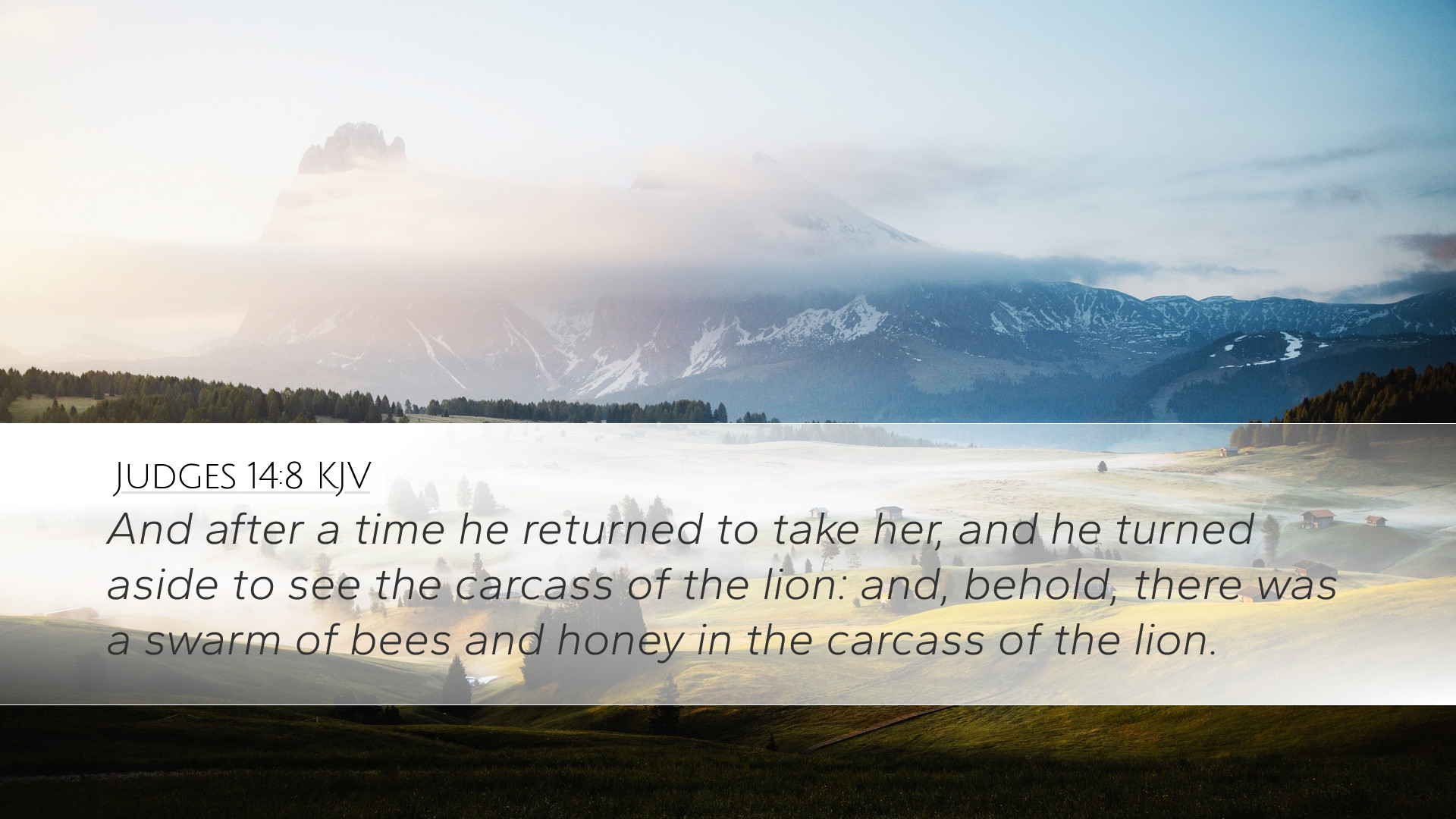Old Testament
Genesis Exodus Leviticus Numbers Deuteronomy Joshua Judges Ruth 1 Samuel 2 Samuel 1 Kings 2 Kings 1 Chronicles 2 Chronicles Ezra Nehemiah Esther Job Psalms Proverbs Ecclesiastes Song of Solomon Isaiah Jeremiah Lamentations Ezekiel Daniel Hosea Joel Amos Obadiah Jonah Micah Nahum Habakkuk Zephaniah Haggai Zechariah MalachiJudges 14:8
Judges 14:8 KJV
And after a time he returned to take her, and he turned aside to see the carcass of the lion: and, behold, there was a swarm of bees and honey in the carcass of the lion.
Judges 14:8 Bible Commentary
Commentary on Judges 14:8
Text of Judges 14:8 (KJV): "And after a time he returned to take her, and he turned aside to see the carcass of the lion: and, behold, there was a swarm of bees and honey in the carcass of the lion."
Introduction
The narrative in Judges 14:8 presents a significant moment in the life of Samson, illustrating themes of strength, providence, and the unexpected revelations of God's purpose. This verse encapsulates a deeper theological message, serving as an essential text for reflection and study by pastors, theologians, and students of Scripture.
Contextual Analysis
Judges 14 delineates the early experiences of Samson, a judge of Israel endowed with supernatural strength. His desire for a Philistine woman underscores his struggle against the Philistine oppression of Israel during this period. The events surrounding his marriage provide a backdrop for understanding the larger ramifications of his actions and choices.
In Judges 14:8, Samson's decision to revisit the carcass of the lion he had slain reflects a duality of life and death, strength and weakness. This journey into a place of death leads to an unexpected discovery, highlighting the intricate ways God orchestrates purpose through seemingly mundane or negative circumstances.
The Symbolism of the Lion and Honey
Henry’s Commentary emphasizes the lion as a symbol of both opposition and empowerment. In Samson's case, the lion represents the formidable adversities he faced, correlating with his judicial role in Israel. The honey found within the carcass symbolizes sweetness and provision, contrasting sharply with the death represented by the lion.
Barnes’ Notes elaborates on this imagery, suggesting that the honey signifies God's blessings emerging from trials. This notion resonates deeply, as believers often find that their most significant growth and revelation occur amidst challenges.
Clarke’s Commentary, in his exploration of the nature of the encounter, draws a parallel to the Christian life, where believers often experience trials (the lion) yielding to blessings (the honey). The honey, therefore, may also represent the sweetness of understanding and insight that comes from enduring life's struggles.
The Lesson of Divine Providence
This verse serves as a vivid illustration of God's providence. Despite the circumstances surrounding Samson's life choices, which may seem reckless or ungodly, God ingeniously utilizes these moments for His purposes.
According to Henry, Samson’s life was filled with contradictions; however, in God's orchestration, not a moment was wasted. The divine plan unfolds, demonstrating how God can extract beauty and providential care from situations that seem chaotic or misguided.
Further, Barnes argues that Samson's actions remind readers that God operates beyond human understanding. Even when individuals stray from God’s ideal through their choices, God's overarching sovereignty works to fulfill His plans. The lesson encourages reliance on divine guidance rather than mere human reasoning.
The Importance of Reflection
This passage challenges readers to reflect on their journeys. Just as Samson returns to the scene of death only to find life and sweetness, believers are encouraged to revisit painful experiences in their lives, seeking the lessons and blessings hidden within. Clarke emphasizes the necessity of reflection for spiritual growth, asserting that the act of examining past trials can yield insight into God’s promises.
Connections to the New Testament
The transformative discovery of honey in the carcass invites connections to New Testament themes of resurrection and new life. The act of finding sweetness amidst death serves as a metaphor for Christ's resurrection—where through death comes eternal life and abundant grace.
As Barnes notes, this narrative foreshadows the ultimate victory of Christ over death, pointing believers to the hope that, in every circumstance, they can find sweetness in the pain through faith in Christ.
Conclusion
Judges 14:8 is a rich text laden with theological significance and practical application. It requires pastors, theologians, and students to delve deeper into the meaning behind the words. As they contemplate Samson's journey and the unexpected treasures found therein, they are encouraged to trust in God's providence—recognizing that even amid life's trials, God’s faithfulness brings forth sweetness.
Through the lens of this narrative, believers gain insight into the character of God and His ability to transform challenges into opportunities for growth and understanding.


